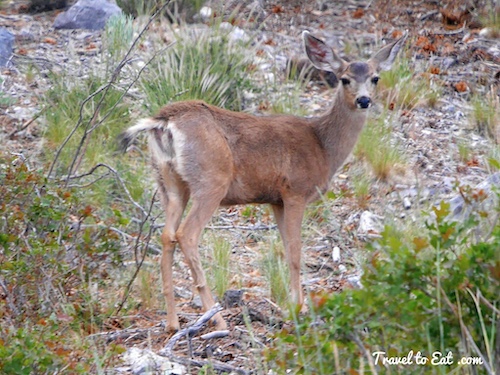
As I said in the last post, we decided to go up to Mount Charleston to get away from the heat. As we went up the mountain, the vegetation became thicker until we were in a pine forest mixed with Aspen. We were lucky enough to to see a family of mule deer halfway up the mountain and I thought I would share the pictures. Mule deer have large ears that move constantly and independently, from which they get their name, “Mule” or “Burro Deer.” During the summer, the coat on the mule deer’s upper body is yellow or reddish-brown, while in winter more gray. The throat patch, rump patch, inside ears and inside legs are white with lower portions running cream to tan. A dark V-shaped mark, extending from a point between the eyes upward and laterally is characteristic of all mule deer but is more conspicuous in males. Mule deer are social animals that typically stay in groups. They live in a multi-generation family of related femalIes and their offspring. Bucks older than yearlings often group together or remain solitary. In late summer and fall, mixed family groups form larger groups that stay together for protection throughout the winter. They break into smaller groups again by the next summer.
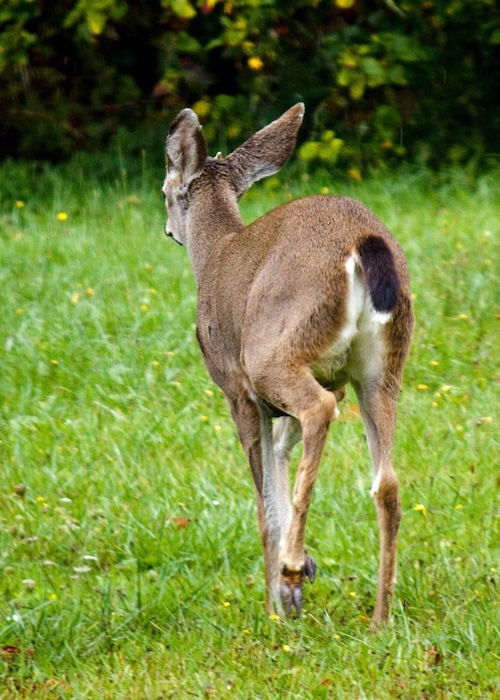
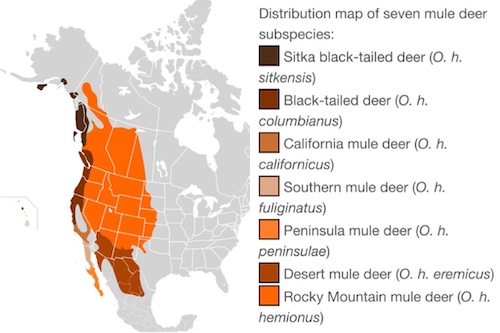
Mule deer and black-tailed deer (collectively called mule deer, Odocoileus hemionus) are icons of the American West, most easily differentiated by the color of their tails. The mule deer has a tail white above, tipped with black (as seen above) and the black-tailed deer has a tail with black or brown above. The two forms of black-tailed deer or blacktail deer that occupy coastal temperate rainforests in the Pacific Northwest are subspecies of the mule deer. They have sometimes been treated as a species, but virtually all recent authorities maintain they are subspecies. There is some DNA evidence to suggest that mule deer resulted from interbreeding of white tail deer and black tail deer although hybrids between the mule deer and white-tailed deer are rare in the wild. As you can see from the map seen above, they are distributed throughout western North America from the coastal islands of Alaska, down the West Coast to southern Baja Mexico and from the northern border of the Mexican state of Zacatecas, up through the Great Plains to the Canadian provinces of Saskatchewan, Alberta, British Columbia and the southern Yukon Territory.
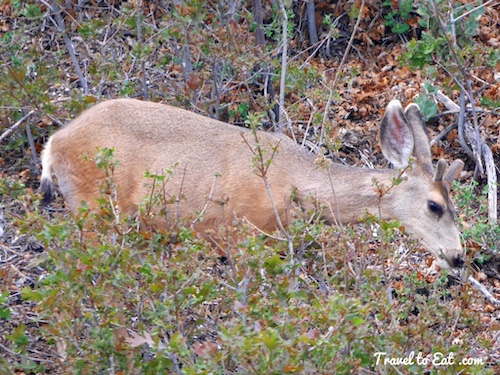
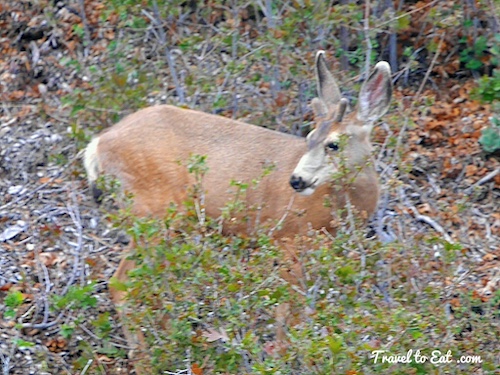
Basic mule deer habitat requirements include an abundance of bushes and groundcover, vegetation and landscapes that provide hiding and access to sources of water. Mule deer generally summer at higher elevations and migrate to lower woodlands or shrublands in winter to find food, avoid predators, and seek cover from harsh weather. Mule deer digestive tracts differ from cattle and elk in that they have a smaller rumen in relation to their body size, so they must be more selective in their feeding. Instead of eating large quantities of low-quality feed like grass, deer must select the most nutritious plants and parts of plants. Mule Deer are browsers and eat a great variety of vegetable matter, including fresh green leaves, twigs, lower branches of trees, and various grasses if necessary. They are particularly fond of blackberry and raspberry vines, grapes, mistletoe, mushrooms and ferns. They eat so carefully they can even consume the fruit of cactus.
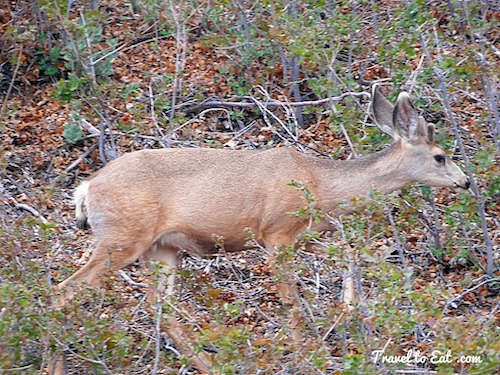
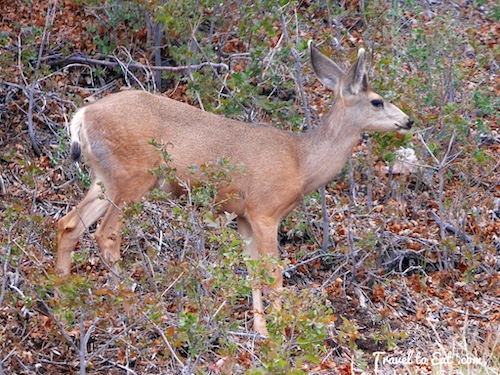
In this family of four mule deer, it appeared that there was only one male. Males (called bucks) have forked antlers. They shed antlers in mid-February and their next set begins to grow immediately after. Only males have antlers, while females (called does) have no antlers. A new set of antlers is grown every year, with the new growth beginning in spring. As the antlers grow, they are covered with velvet, a layer of skin rich with blood vessels and nerves that nourish the bony antlers. In late summer, as the daylight hours gradually decrease, hormonal changes in the buck causes the antlers to harden and the blood supply shuts off. The velvet becomes dry and is eventually rubbed off, leaving only the bony antler. During the rut, or mating season In December, bucks establish dominance by using their antlers in sparring competitions. Antlers are actually an extension of the the skull.
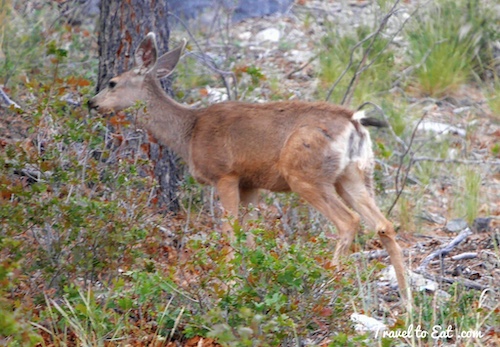
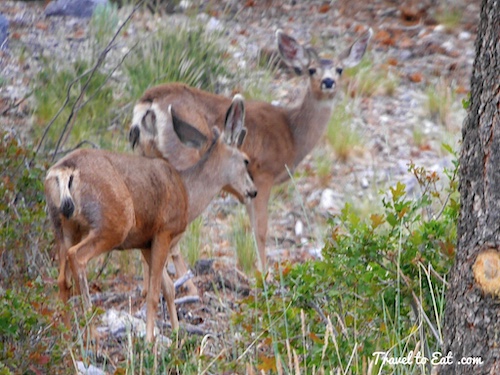
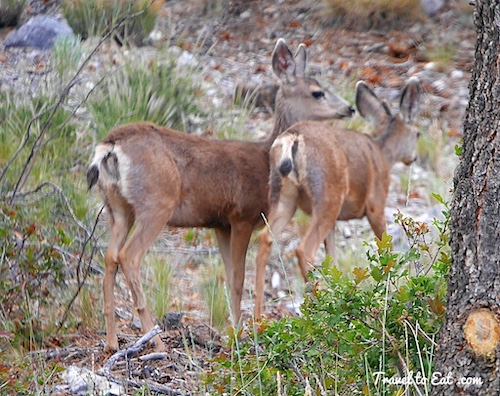
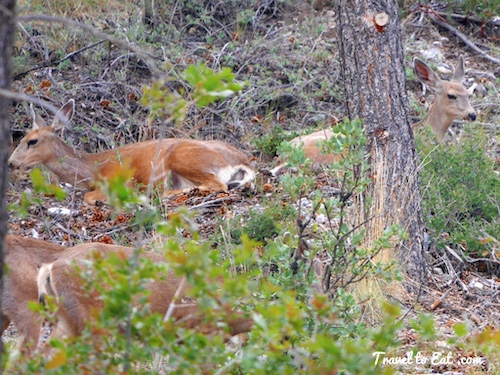
Mule deer are most active in the morning and evening, spending most of the daylight hours bedded down under cover where they are hidden from predators. In the above photo you can see two female mule deer resting although they were hard to spot when we were watching the other two feeding. Mule Deer have a four-chambered stomach and will re-chew partially digested food when resting (chew their cud). This allows deer to digest fibrous leaves and twigs.
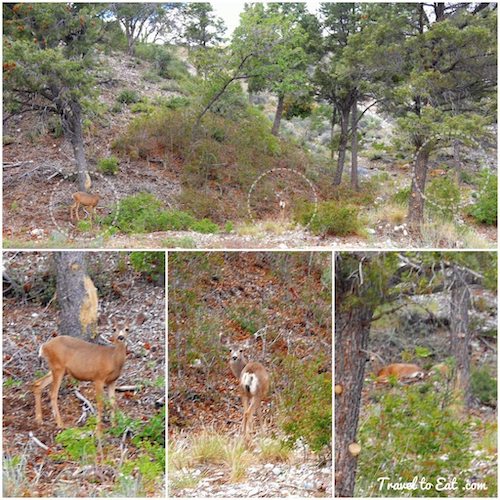
Mule deer move between various zones from the forest edges at higher elevations to the desert floor, depending on the season. Generally, they summer at higher elevations and winter at lower elevations, following the snow line. Mule deer occupy almost all types of habitat within their range, yet they seem to prefer arid, open areas and rocky hillsides. Areas with bitterbrush and sagebrush provide a common habitat. Mature bucks tend to prefer rocky ridges for bedding grounds, while the doe and fawn are more likely to bed down in the open. Seasonal movements involving migrations from lower elevations (winter ranges) to higher summer ranges are associated, in part, with decreasing temperatures, severe snowstorms, and snow depths that reduce mobility and food supply during winter. Because it is summer here they were comfortably wandering at higher altitude.
[mappress mapid=”102″]
References:
Mule Deer Foundation: http://www.muledeer.org/hunting/mule-deer-facts
Desert USA: http://www.desertusa.com/animals/mule-deer.html
NRCS Mule Deer: http://www.wildlifehc.org/new/wp-content/uploads/2010/10/Mule-Deer.pdf
PBS Mule Deer: http://www.pbs.org/wnet/nature/touching-the-wild-infographic-north-americas-mule-deer/8784/

